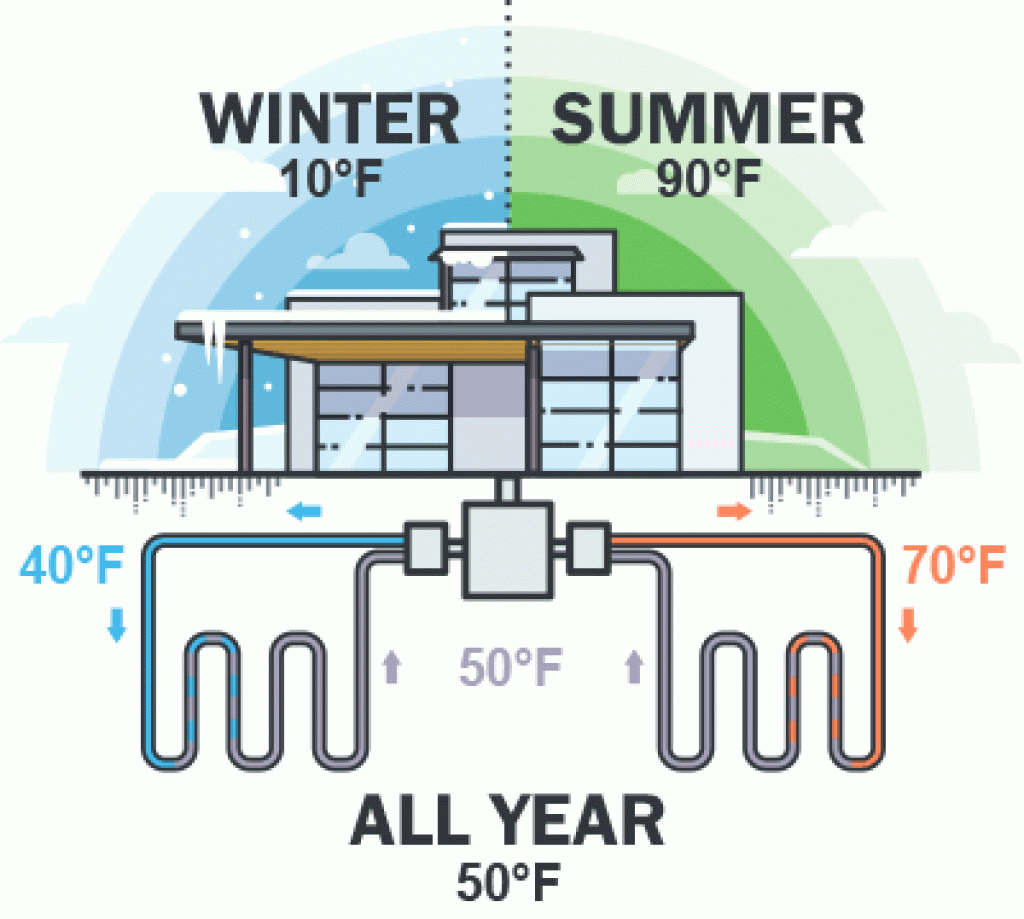If you’ve been looking into alternative energy, you may have heard of geothermal energy. And if you’re reading this, you probably know what a geothermal heat pump is. We know they’re efficient, but what about a geothermal heat pump’s electricity usage?
Most of the information on geothermal heat pumps refers to Btu production. While this gives us an idea of how well geothermal heat pumps perform, it doesn’t give us a wattage.
You may have even tried to convert British thermal units to kilowatt-hours. Except, the figures just don’t add up. So how do you calculate the wattage of a geothermal heat pump?
That’s where we’ve stepped in. Below, you will find a short yet comprehensive guide on how much electricity a GHP uses.
Table of Contents
How Much Electricity Does A Geothermal Heat Pump Use?
It’s difficult to say what a geothermal heat pump’s electrical usage is. Various factors influence this value, such as the environment and the size of your home.
The most significant factors here are COP, EER, and SEER.
- COP stands for coefficient of performance — a ratio between heat provided in Btu and Btu energy out.
- EER is the heat pump’s energy efficiency rating. This measures how efficient the heat pump is at peak cooling time.
- Lastly, SEER stands for seasonal energy efficiency rating. The rating measures the heat pump’s efficiency in varying temperatures.
To determine your geothermal heat pump electrical usage, we need to define two factors. First, the tonnage or size of the system, and then it’s SEER.
Calculating The Size Of Your GHP
The U.S. Department of Energy Office of Scientific and Technical Information sheds some light on this matter. According to them, one ton of heating/cooling capacity is 12,000 Btu.
Btu stands for British thermal units and describes the capacity of AC units and heat pumps. The size of your heat pump also determines how much electricity it uses. And to select the size, you have to calculate the required Btu.
To do that, we can look at this simple equation:
Since the average American home is 2,261 square feet, you’ll need 67,830 Btu. That’s equal to 5.65 tons of capacity.
In conclusion, you’ll need a geothermal heat pump with a 6-ton capacity.
Find The SEER Of Your Unit
This is the easy part. Most units, AC, air heat pumps, or GHPs, come with a label stating it’s SEER. (Alternatively, you can always look at the statistics sheet of your unit to find its SEER value.)
You need this rating to determine the efficiency of your geothermal heat pump. Once you know the pump’s efficiency, you calculate its electrical usage.
The best SEER rating you can get for your GHP is 30. With this rating, you’ll be able to save 50% of the energy you would have used with an AC unit.
What Is The Geothermal Heat Pump Electricity Usage Of A 6-Ton Unit?
Finally, it’s time to calculate your geothermal heat pump’s electrical usage. The next step may seem complicated, but it’s a formula that requires you to plug in your values.
Total Wattage = Capacity ( Btu ) ÷ EER
But wait, notice how this formula requires the EER value? Again, don’t confuse SEER with EER — as we mentioned above, these are two separate ratings.
To convert our SEER to the EER, you can use this equation:
EER = −0.02 × SEER² + 1.12 × SEER
Let’s walk through it.
EER = -0.02 x 30² + 1.12 x 30
∴ EER = (-0.02 x 30²) + (1.12 x 30)
= -18 + 33.6
= 15.6
Our EER value is 15.6. So let’s plug that into the first equation.
Total Wattage = Capacity ( Btu ) ÷ EER
= (6 x 12000) ÷ 15.6
= 4,615 watts ~ 4.6kW
In conclusion, a 6-ton SEER 30 geothermal heat pump uses 4.6kWh of power. An airconditioning unit of the same size would use roughly 7kWh.
Similarly, a 3-ton SEER 30 geothermal heat pump would use 2.3kWh, while a 3-ton AC unit would use 3.5kWh.
Why Do Geothermal Heat Pumps Use Such Little Electricity?

Source: dandelionenergy
The answer to this is quite simple. Instead of using electricity to generate heat, it transfers heat from one source to another.
So, what does a geothermal heat pump’s electricity usage go towards?
A geothermal heat pump uses electricity for its compressor, fan, and circulation pumps.
Only 1/4 units of electrical energy are used to create an output of 4 units of heat energy— the other 3/4 units of heat coming from the ground.
In contrast, combustion furnaces use 4 units of input energy to get 4 units of heat energy out.
Is Geothermal Energy Efficient?

Source: burlingtonelectric
Geothermal heat pumps are efficient in many ways. Due to their efficiency, they use less electricity than conventional furnaces and air heat pumps. According to the EPA, GHPs use 72% less energy than a traditional furnace.
Why Is A Geothermal Heat Pump’s Electricity Usage So Efficient?
- They use existing heat
- They use a great heat conductor
- They have multiple uses
Saving Electricity By Transferring Heat
Geothermal heat pumps take advantage of the earth’s constant temperature to warm your home. Unlike conventional furnaces, they don’t depend on combustion for heat.
Instead, the ground warms the water in the GHPs system, which stays at a steady 45°F (7°C) to 75°F (21°C). The water then passes through a heat exchange and a compressor, creating warm air for your home.
Lastly, GHP effortlessly moves the warm air from your home and back into the ground. This is a much more effective way than using an AC unit to cool your house.
GHPs Use A Great Conductor — Water
Most geothermal heat pumps use water to transfer the heat from the ground to your home. Water is a great conductor and is much more efficient than air.
Air is a known insulator that prevents heat transfer in windows and even travel mugs. This gives the GHP the edge compared to an air heat pump (AHP).
In freezing climates, GHPs use anti-freeze liquid in their system. And while this isn’t water, GHPs are still more effective at removing heat than AHPs.
Geothermal heat pumps are multifunctional.
GHPs are more efficient than furnaces or ACs because they are multifunctional. They warm your house in winter, keep it cool in summer, and can create hot water for your home.
Some outdated homes would require a furnace for the winter and air conditioning for the summer. These houses would require more than one system in the place of one GHP.
It’s also fair to note that an AHP is also multifunctional, heating and cooling your home.
Final Thoughts
To summarise, a geothermal heat pump is an efficient way to heat and cool your home. It’s 72% more efficient than conventional heating methods and 44% more efficient than AHPs.
The calculation to determine your geothermal heat pump electrical usage is easy:
- Firstly, you need to know the area of the space you’d like to heat and the SEER of your heat pump.
- Secondly, use the equation above to convert your SEER to EER. Lastly, calculate the system’s total wattage.
If you multiply your total wattage by the electricity rate, you see the operation cost of the system.
Finally, we looked at why geothermal heat pumps are efficient and use little electricity.
If you’re hooked on the topic of geothermal energy, join our community! We’d love to chat with you and share ideas and thoughts.

